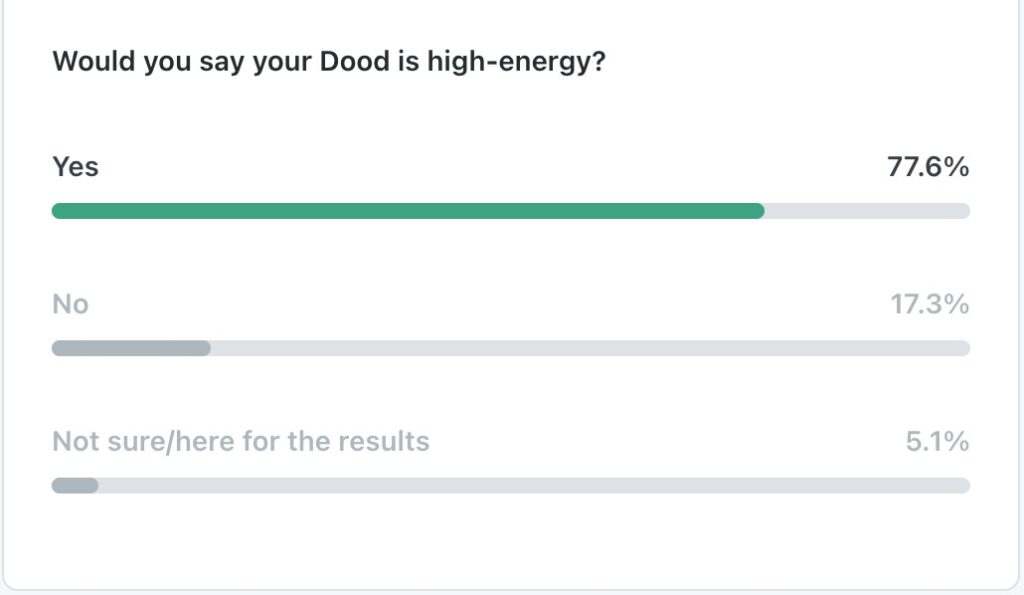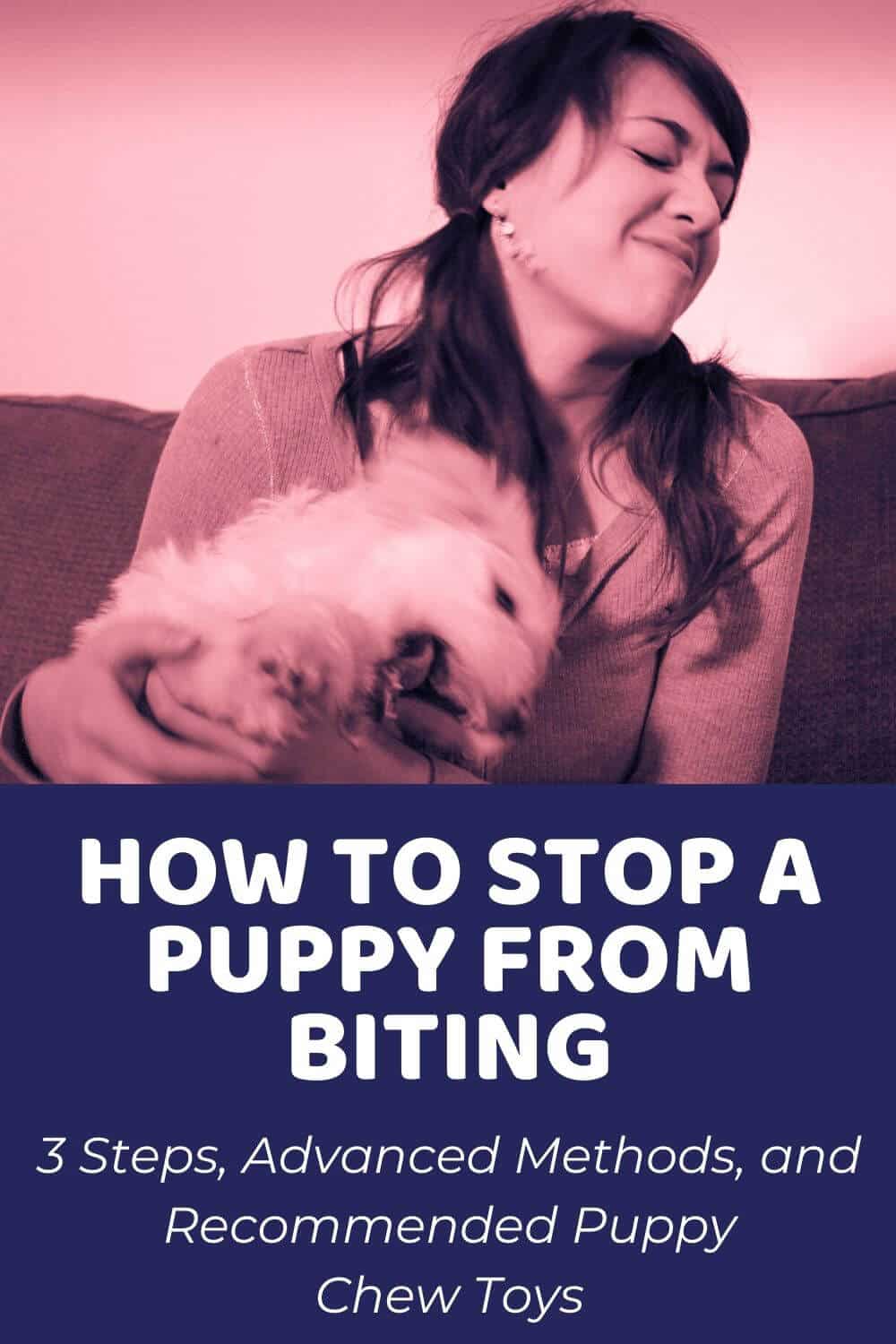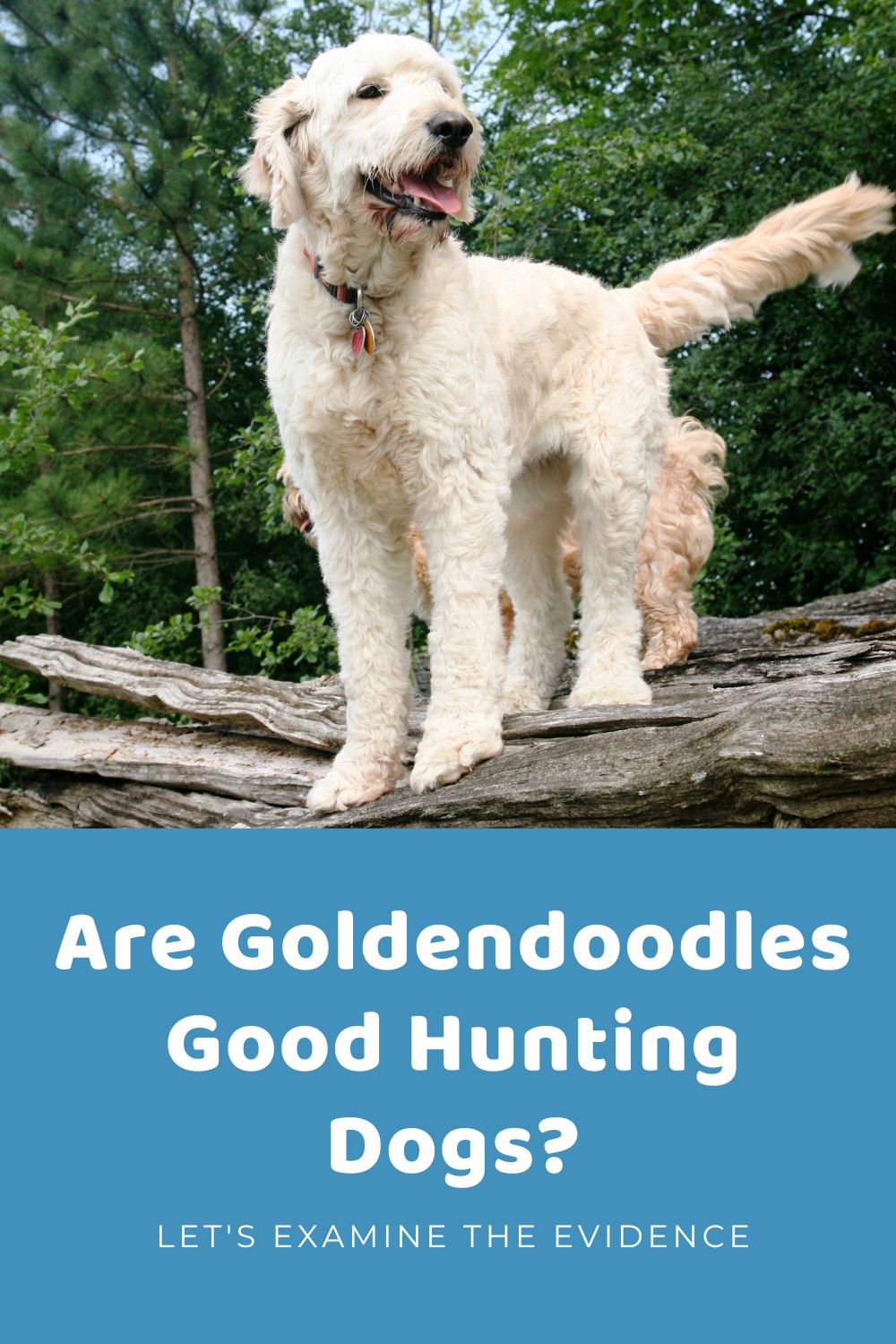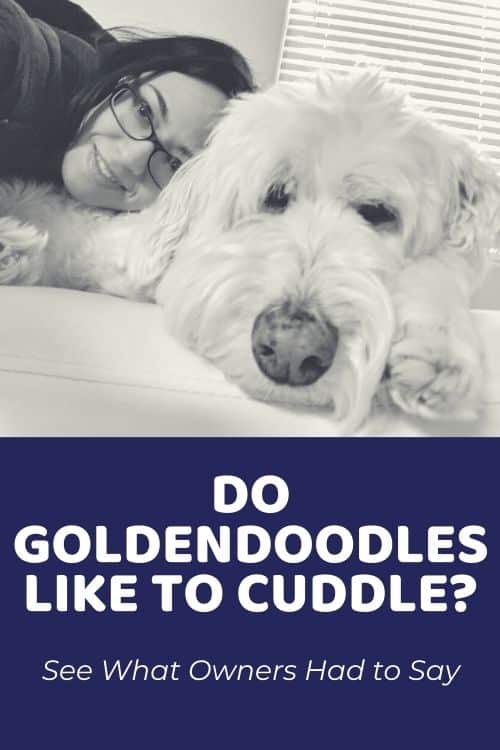If you’ve ever had a puppy, you’ll know they can be excitable little critters. While it’s lovely to see them frolicking around, enjoying life and your company so much…even with the best will in the world, it can get a little much after a while. That’s when you might start to wonder when do Goldendoodles calm down – if and when?
Don’t despair. It will happen at the right time and under the right circumstances. Keep reading to discover what both of those might be and how your puppy will change as they mature. We will also cover how you can teach your dog the kind of good manners that will enable them to remain calm even when dealing with new people, different places, and other dogs too.
Table of Contents
- Are Goldendoodles Hyper Dogs?
- Goldendoodles Behavior Stages
- Ways To Calm Your Goldendoodle
- Does Neutering Goldendoodles Make Them Calmer?
- Frequently Asked Questions on Goldendoodle Energy Levels
- When Do Goldendoodles Calm Down: Conclusion
Are Goldendoodles Hyper Dogs?
The thing that makes Goldendoodles so incredibly popular as pets – especially with families that have children – is their outgoing personalities and the fact that they have a real zest for life. Vibrant, social dogs, Goldies do tend to be high-energy and boisterous pups right through their lives, which many owners love about them. You need to be prepared for this before deciding to take one of these darling dogs on.
However, high-energy and boisterous doesn’t necessarily mean out of control. Sure, when Goldendoodles are puppies, they may run you ragged with their cheeky, mischievous behavior. After all, all dogs struggle to control their excitement when they are young. That’s why reprimanding puppies so rarely works. Yet, also like other dogs, Goldendoodles, too, do mellow as they age into adults.
We also asked our newsletter subscribers if their Doods are high-energy. Here are the results:

Goldendoodles Behavior Stages
Early Puppyhood
During the first 8 weeks of your puppy’s life, when they are still with their mom and siblings, they will be learning much about the business of being a dog. As they move from the neonatal period to the transition period to the socialization period, they will not only learn vital motor skills and start to play, but they will also begin to develop relationships with the other dogs and people around them.
This stage is crucial to how your pup continues to relate to other animals and people as they grow. A top-quality breeding facility will ensure their puppies get plenty of handling and exposure to new stimulation. They will also make sure that all time spent around people is very positive for your pup. These early experiences shape how your dog will continue interacting with people throughout their lives.
When you finally bring your Goldie home, they will be slap bang in the middle of the first fear stage. This often lasts from 8 weeks up until 10 weeks. Don’t be intimidated by the name, though. Although dogs are very sensitive to new experiences, especially negative ones, during this brief period, a lot of love, delicious treats, and avoiding activities that seem to spook your pet can help them successfully navigate it.
The remaining 2 weeks of these vital first 3 months are the best time to get going with their early training. This golden window of opportunity shouldn’t be missed. This is when you are going to lock in toilet training and teach your puppy how to behave around the house. At the end of this period, your puppy isn’t going to be behaving perfectly. Still, they will be well on their way with the basic and most important aspects of training – the actions that will set them up for life.
Late Puppyhood
By the time they hit 3 months, your baby isn’t going to feel like such a baby anymore. Depending on their Doodle type (Standard, Mini, Medium…), they could be anywhere from half to most of the way to their adult size. Yet you will need to remember that they are still very much a puppy in their thinking and how they respond to things. At this time, it will still be all too common for them to become so frantic and over-excited that their good manners and their training go right out the window.
You may also start to see an increase in undesirable behaviors such as chewing as their teething really ramps up. Keep this in check by providing appropriate chew toys for them to chow down on. This can help save both your belongings and your poor fingers – ouch! Make sure also that during play, you are very consistent in what you are letting your hound get away with. Mouthing behaviors are only natural, but let your dog know when they go too far with loud pain noises. Withdraw from the play altogether when they push things too far.
Training will also need to be stepped up in this period as your pup will begin to test the boundaries of what they can and can’t get away with. Remember that it is far easy to train proper behavior from the beginning than correct it later in life. Your dog may try to assert their dominance over you at this time. It’s essential that you keep reminding them of their place in the pack – not with reprimands or punishments, but through consistent, positive methods.
Adolescence
If your pet hasn’t started challenging their training in later puppyhood, you can be sure that it is coming when they hit 6 months, the adolescent stage. Like teens, adolescent dogs are all about finding their place in the world. This is when that early training is really going to come into play, as you will be able to redirect their negative behavior and reconfirm the boundaries that they are already more than well aware of.
In this stage, your pet’s playfulness could increase tenfold, and it is really going to seem like you cannot possibly tire your dog out no matter what you do. Remain vigilant, though, as part of the testing of what they can get away with involves beginning to think about escape. Now’s the time to make sure there are no weaknesses in the yard fence or fraying of the leash that they could take advantage of. Make thorough use of toys and games throughout this period.
Adulthood
Just when it feels like you have hit the end of your tether for one bouncy pup all about the place, your Goldendoodle will enter adulthood (somewhere around 12-18 months) and start to calm down. While some days it may still feel like your cute canine has ingested an entire pot of coffee or turned into a Mexican jumping bean, especially in the first few years of their adult lives, in actuality, they will have much more control of their own behavior now.
Ways To Calm Your Goldendoodle
While the only fail-safe way to prevent undesirable actions caused by overexcitement in puppies is through diversion and prevention, your dog’s control over their behavior will only increase as they continue to age. They should hit their golden years somewhere between 8 and 12 years of age, depending on their size.
However, in the space in between, when you feel like you have a whirling dervish of a dog on your hands, you can help keep your dog’s energy and negative behaviors like barking, jumping up, and general destruction of your property in check with the following:
Regular Exercise
All dogs require daily walks to help keep them in good health and spirits. With that infamous Goldendoodle vivacity, this is especially vital for these pups. Just one missed walk could result in a serious energy spike that you’re probably not going to enjoy all that much. While many people opt for a single long walk, it might actually be better to break this down into two or more longer ones spread across the day – somewhere between one and two hours per day, depending on your pet’s size, age, and individual energy levels.
A garden is great for bigger dogs as they can happily chase a Kong Toy or something similar about the place, effectively keeping themselves out of trouble. Alternately you could send the kids out with them, and they could all wear each other out, resulting in a lovely peaceful evening for you. If this is not an option, games of fetch in a well-secured dog park can do the trick just as well. A dog-walker can also help take some of the strain of exercising a particularly lively Dood.
Mental Stimulation
Boredom can be the absolute enemy of calm, especially when something noteworthy does happen, such as the arrival of a visitor or a trip around the block. If your pup is frequently left alone for long hours, you will find that they are extra-especially lively when they finally get their family back home with them and have something to do again (and someone to do it with).
Again, this is where canine toys can save you a lot of hassle. These days there is an excellent variety of them with some seriously cool features. The thing about Doodles is those Poodle smarts of theirs make them particularly susceptible to boredom. Puzzle toys offer intellectual challenges whereby your pup has to figure out how to get to a tasty treat, for example. This can easily keep them entertained for hours at a time. The result is a much calmer, happier dog who may not even notice when someone does ring the doorbell.
Training
Training and socialization are also both so, SO necessary for helping your Dood manage their own behavior. We’ve touched on both of these above. Socialization gets your pooch accustomed to meeting new people, being in unfamiliar places, and dealing with different dogs and other animals. Training puts specific commands at your fingertips which can be employed when your pup is getting a little too over the top.
Positive reinforcement is a good strategy, but be sure you are only reinforcing the behaviors you want to see continued. If you make a fuss of your fur baby when they are running around or jumping up, if you act as delighted to see them as they are to see you, then you are telling them with your actions that this is the right thing to do. Make a real effort to only pay attention to your pooch only once they have calmed themselves down.
New Activities
If you have the time, then helping your dog learn new tricks and skills can go a long way to keeping them both physically and mentally happy. Canine sports were practically invented for these offspring of working dogs. They excel at so many of them and will thoroughly enjoy participating. These kinds of activities also serve to reinforce and extend their basic training giving you even more commands you can use for behavior control.
Goldendoodles are also big fans of the great outdoors in all its forms. So, you shouldn’t shy away from taking your four-legged friend away with you on camping trips or hikes or even out for a run with you (once they are passed the puppy period and have stopped growing – you don’t want to put unnecessary pressure on bones and joints that are still developing). Goldies, being the descendants of two water-loving breeds, will also likely love the chance to swim and hang about in streams, lakes, rivers, and the ocean.
Frozen Treats
If you are doing all of this and more and you’re still finding your pal is running rings around you on a daily basis, the issue could be with their diet. Too much of certain kinds of foods could heighten energy to unmanageable levels. Pay attention to kibble ingredients to make sure that they suit your dog’s age, life stage, and activity levels. Also, take care with the amount that you are feeding your dog each day.
Likewise, snacks can cause issues here. A surprising number of calories can be found in even the tiniest treats. If you are using these for training, you may consider switching them out for a clicker or praise-based methods. If your food-focused friend is clearly never going to go for that, a surprising alternative is frozen vegetable treats. These seem to go down very well with most Doodles, according to their owners.
Does Neutering Goldendoodles Make Them Calmer?
A commonly held belief with canines is that getting them fixed can help them to be calmer, and there is some truth in this. While spaying dogs doesn’t alter their personality any – a happy, bouncy pup is always going to be happy and bouncy – it can impact their mood and the way they behave, reducing aggressive acts and territorial marking, for instance. Your puppy will likely be every bit as rowdy, but your older dog will be less of a puppet to their hormones.
Frequently Asked Questions on Goldendoodle Energy Levels
When do Goldendoodles calm down?
Goldendoodle puppies, like all other puppies, are feisty, fast, playful little things. This lasts a lot longer than you might think, given how quickly they grow to their adult size. Somewhere between 12 and 18 months of age, your dog will mature, and this will be when you will see them having a little more control. Although, they will likely be every bit as energetic as they ever were. This can be tempered somewhat through exercise and play.
Is it normal for a Goldendoodle to be energetic?
High-energy levels are a feature of the Goldendoodle breed and a trait that they inherit from their intelligent, working-dog parents. In this respect, it is perfectly normal for your Goldie to enjoy plenty of walks and fun. However, in adulthood, there is a clear distinction between a boisterous dog and a badly behaved one, so you need to keep on top of your pooch’s training to ensure you have the commands required to control their behavior when things do get a little too fun for them to handle.
How often should I walk my Goldendoodle puppy?
Daily walks are a necessity for every dog, although some breeds require a longer time outdoors than others. Goldendoodles have quite high exercise needs compared to some of the smaller, more sedate Doods. Although this will need to be tailored to their age, a good rule of thumb is to exercise them for five minutes per month of their age – twice a day. So, with a 4-month puppy, two 20-minute walks a day would be sufficient to keep them happy and healthy.
When Do Goldendoodles Calm Down: Conclusion
If you’re looking for a quiet little lap-dog type in your life, chances are a Goldendoodle, even a mini Goldendoodle, is not the dog for you. Although energy levels of these fine canines vary depending on age, life stage, and individual differences, they do tend to be at the higher end of the spectrum. For this reason, they do best in high-energy family homes or with people willing to take them on plenty of long hikes and with both a garden and the time to play with them. If you think that you can offer a Goldie that kind of life, then you will, no doubt, end up adoring your newest family member almost (but not quite) as much as they will adore you.
Learn How to Care for Your Doodle Puppy!

Perfect for first-time Doodle parents, get ALL your questions answered, including questions new Doodle parents don’t even think to ask.
Plus, get $700 worth of Bonus Materials for FREE, including:- Doodle Parenthood Community and Support Group ($190 value)
- Doodle Puppy Growth Tracker ($20 value)
- EMERGENCY Cheatsheet: When To Call The Vet Immediately ($50 value)
- HELP! Button ($145 value)
- And SO MUCH MORE!














